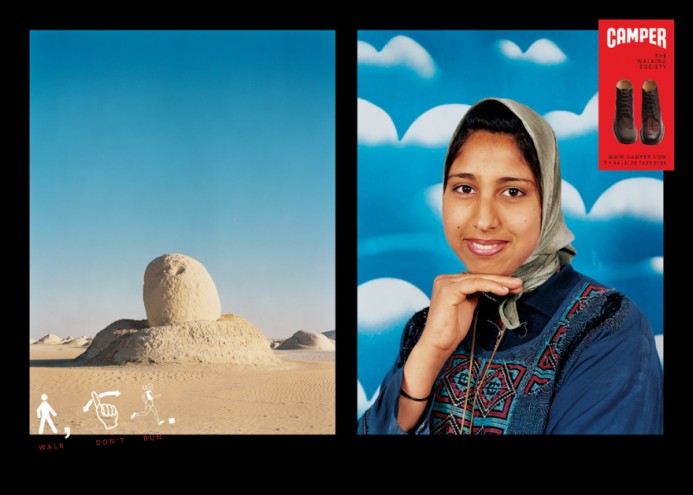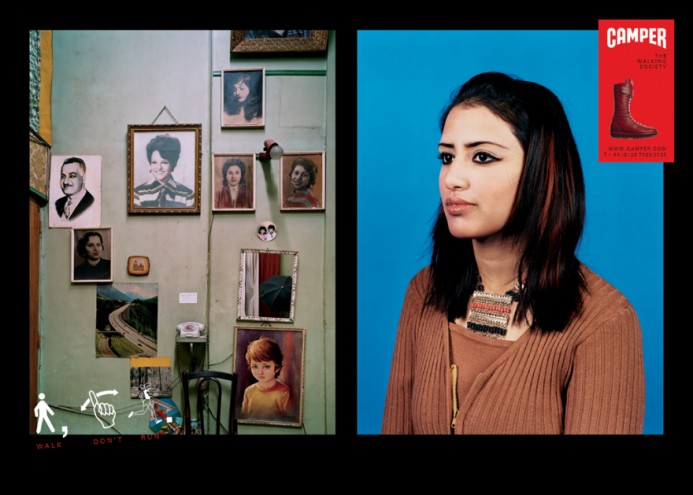First Published in
A lot has been said of Shubhankar Ray’s choice of locations for his print ad campaigns. Maybe it is because they do not conform to any obvious fashion archetype: Mallorca, Provence, rural Italy. But it is not just his choice of settings that is different. It is also the subjects he chooses to frame. There is hardly anything unattainable or ineffable about bocce players from Italy (for Camper shoes) or construction workers from Japan (for Caterpillar).
Shubhankar Ray’s “urban reality-based image and visual concept”, as his style has been paraphrased, has a way of debunking set notions about lifestyle advertising. His work also has the ability to disarm hardened cynics, and I don’t mean those grizzled types who make a profession out of having an opinion: critics and columnists and media pundits – not those types. I am referring to an even more distrustful constituency: you, me, us. Stock standard, everyday people. People so attuned to flicking through magazines that we have become accustomed to ignoring the ads. Shubhankar Ray makes us pause. Stop.
Celebrated as one of London’s top 100 power people, Ray works in close conjunction with the US-born photographer Stefan Ruiz (recently creative editor of Colors magazine). Ray has used the quiet solemnity of the Ruiz’s documentary images to inform such projects as The Walking Society, a biannual magalogue (magazine/ catalogue) that takes the reader to a different Mediterranean country each issue. The publication is meant to reference (and reinforce) the cultural zeitgeist underpinning the projects sponsor, a family-run Spanish shoe company founded in 1877, Camper.
Of course there is nothing new is such creative tactics, of using images unconcerned with fashion to vest a brand principle. Simply think of Benetton. But it is not novelty that inspires Shubhankar Ray. The Calcutta-born creative director wants to redefine the way we look at advertising - and its place in the world.
Where did you ground yourself in advertising and learn the ropes? Did you have any mentors as such? What hinted at the direction you are following now?
Initially after leaving university I was an environmental scientist by day and involved in music and club culture by night. Eventually I worked out how to get a job connected with what I was interested in (image, music and fashion). I started working with J Walter Thomson and Ogilvy & Mather in London and thought: “This is shit - but it doesn't have to be”. So then I got a job with Levi's where I began to learn and receive some guidance through the people I worked with (mainly the people who set up i-D magazine). This is how I met the photographer Stefan Ruiz.
I learnt the ropes while at Levi's working with BBH in London. After five years I decided to do it on my own and began my collaboration with CAT, where I took the risk of believing in my own ideas and vision. The work was successful worldwide and ended-up in art galleries in Europe. I continued to be influenced by the people I was working with (blue source… Leigh now wins MTV awards and Grammy nominations for his pop videos... Massive Attack... Asian Dub Foundation, etc.) Most of my influences are from worlds that are different to mine: music, social activism, fashion, etc. They make me re-consider and re-frame my worldview.
Now that you mention influences, let’s get an obvious question out the way. Who are your key influences?
My anthropologist father, travel as a kid, Rabindra Nath Tagore. Musically I was influenced by the music of The Fall, New Order (including the work of Peter Saville for Factory Records), Lee “Scratch” Perry and hip hop. Situationism and street style are also influences. Basically I grew up as a displaced immigrant teenager in England during the 1970s and 1980s. At the moment I'm quite influenced by Miguel Barcelo (a painter) and I guess I'm influenced by lots of disconnected things in which I find strange random connections.
This leads well into my next question. The art direction of your print campaigns is highly visual. Often the image/s bear no relation to the product. Why this approach?
In today's accelerated consumer culture people are exposed to an overdose of information, products and empty messages so they notice less and think about [the encounter] even less. In this environment a universal language - using photos, film and music - can work across the world irrespective of language and borders, because today images & sounds are everywhere in our culture. Crossing borders from country to culture creates misunderstanding, which I like because the way Camper's The Walking Society campaign is created leaves the interpretation to the audience.
For this to work my approach is to create and design a visual language based on images, film and music as the alphabet. The images and films bear no link to product but are related to the philosophy of the brand. In the case of Camper, they are remixed to present an alternative point of view about the Mediterranean, thus reinforcing Camper's geographical origin. The approach is psycho-geo-graphic, i.e. it emphasises the emotional impact of environment.
Was it difficult to convince your clients (Camper and Caterpillar especially) to buy into this approach?
My work process is about creating a body of work over a period of time (non-seasonal and un-fashion), which results in a visual language to re-frame the brand image. My relationship with the brand is collaborative and not a normal agency-client, or independent creative-client structure. For Camper and Caterpillar they just needed to decide whether my work as a visual/cultural sampler and re-mixer of image, film, sound & content was how they wanted to construct their brand image. In both cases the brand owners wanted to create a different image and indulged a particular line of thinking based more on mindstyle rather than lifestyle. They didn't buy another ad campaign but rather collaborated in the design of an idea transmission system for their respective companies. It's always difficult to get people to buy new approaches but fortunately not everyone wants the same old shit. Some people want experimental work because they want progress more than they want maintenance.
How did your association with Stefan Ruiz come about? What is it that attracts you to his photography?
I have known Stefan for over ten years and have worked with him on campaigns for Levi's, Caterpillar, Camper, etc. We have both spent a lot of time travelling so hopefully we don't have a touristy view of a place and can offer an alternative point of view along with some surprising images. Working with Stefan I learnt how to look at images and edit photos. He had an influence on my eye, on my ability to see the world from another point of view. I like working with Stefan because he is interested in the normal and ordinary, which when you look a second time is un-normal and extra-ordinary. This is the raw material or subject for my work. I also like the super-real quality of Stefan's photos (large format, etc.) Also, the fact that as a photographer he is not only thinking about the aesthetic but also understands my concept.
To what extent are you involved in the actual process of searching out appropriate locations?
I normally decide on the locations and then scout both locations and characters, generally on my own. Then I meet with Stefan on location and spend a couple of weeks to construct and shoot the photos. He often helps with casting. I work more like a film director using my scripts based on random connections and direct the photographer/cameraman to follow a shot list based on some weird narrative or conflict.
In a Design Week article, you said: "Camper's approach to media is highly modernistic. The Walking Society (TWS) is a response to globalisation." Can you elaborate on what you meant here?
What I meant was that often millions of dollars are spent on global ad campaigns that promote empty messages. I think it's possible to take a low-culture, hard-sell medium like advertising and fill it with more meaningful contents, a higher level of art that can lead to a change of context. My work is concerned with the relationship between subject-context-media so often I try to take a modern approach to media using not only pages in glossy mags but also film projections into the street, gallery installations in shops, web/ CD-rom/ DND, a bi-lingual magazine, etc. As a consequence, Camper has an integrated media transmission system that can create resonance for a small local brand in the big global world.
TWS was created as a result of globalisation, media un-reality and consumer cynicism. Not all brands are money grabbing capitalists selling more products that we don't need. Maybe some brands can project an honest reality with social responsibility and ethics (cultural capitalism). In TWS, showing super-real, contradictory images of a Mediterranean reality also proposes an alternative to the Anglo-American model of globalisation and consumption where everybody is sexy and cool. Some previous examples from the TWS campaign include the old men with big balls and small cars, which was shot in Napoli; also the camels, Bedouins and modern day Cleopatra shot in Cairo; as well as the bee-keepers and dance couples shot in Provence.
I’d like to refer back to another published quote. In a Sleaze Nation article, you said: "I'm not just interested in doing something that my friends can appreciate, I'm interested in touching far more people." Do you think there is still a lot of narcissism in contemporary advertising?
Yes I guess there still is a lot of narcissism in contemporary advertising. Most ad agencies are focussed on celebrity, money and awards; they are not exclusively focussed on a brand or on the audience. I'm more interested in listening to the audience or the brand, which normally tell me what's wrong with my work thereby acting as both critic and filter. I can always ask my friends or the ad industry when I want to be told I'm great. In the end, the words are all bullshit and will be forgotten tomorrow but if the work is good it may last a period of time and be difficult to forget.
You have refuted comparisons to Benetton/ Colors. I am curious nonetheless to know your thoughts on Tibor Kalman and Oliviero Toscani, thoughts in the sense of whether you see them as forebears/ influences, or simply personalities with a similar vision?
I have respect for how Kalman and Toscani changed the communication landscape. When I was young, their work for Benetton/ Colors had an impact and no doubt influenced my work. I totally see them as originators, people who showed that it was cool to give a shit and create more meaningful communication. I think of them as personalities with a similar vision to mine. Hopefully I can continue to experiment with the instruments of image-making and design to create visual language systems that are good enough as work to be compared in any way to these guys. If I can add something that leads to progress in the hallucination of reality promoted by contemporary advertising then they are my forebears and a significant influence.




















